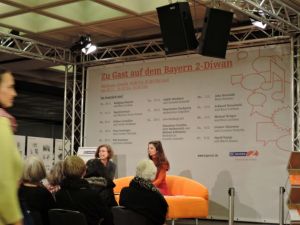 More photos from the Buecherschau, as promised. The event has been well attended, with visitors browsing the book stalls, relaxing in the chairs provided, and reading into the late hours! It looks like everyone feels at home here, eager to get to know books and authors, touch and feel the texture of book covers and pages.
More photos from the Buecherschau, as promised. The event has been well attended, with visitors browsing the book stalls, relaxing in the chairs provided, and reading into the late hours! It looks like everyone feels at home here, eager to get to know books and authors, touch and feel the texture of book covers and pages.
One of the free events I attended was a daily half-hour interview (part of series) for a radio book magazine, the Bayern 2 Diwan. The interviewee, French author Hélène Grémillon, spoke about her new book, In the Time of Love and Lies (German distributors’ title; in French the title is La Garçonnière), set in Buenos Aires in the late 1980s. Very interesting book, with a thrilling plot (a love/crime thriller) and characters (such as a psychoanalyst, and his wife, a tango teacher and murder victim), in addition to the wonderful setting…
Grémillon claimed that in Buenos Aires, there are, and have been, great numbers of psychoanalysts per capita. Imagine that! Even at the time of the Junta, she pointed out! While I am aware of the important connection between Argentina and psychoanalysis, I have not thought of it in terms of numbers. You can understand that, though it is a few years since I last worked as a psychotherapist, my curiosity peaked. So, addicted as I am to checking, I looked it up.
An article on CNN said so too. Indeed, the country has the unusual distinction of being home to more psychologists (i.e. when we include psychanalysts and psychiatrists) per capita than anywhere else in the world. While there are no WHO statistics for 2011, psychologist Modesto Alonso and colleagues estimated 202 psychologists per 100,000 for Argentina in a 2012 study. Compare that with WHO’s 2011 numbers for Austria being 80 per 100,000! And, as it happens, almost half the country’s psychologists are concentrated in the capital city of Buenos Aires.
 But why this interest in the vicissitudess of the psyche? Theories abound. From the influence of the European immigrants, bringing with them the particular culture and society values of twentieth century Europe, through the interest in exploring the psyche of suffering, to the interest in the expression of the self – after all the tango is seen in these terms too – it seems that psychoanalysis not only flourishes in Argentina, but the country is a torchbearer for it. Particularly surprising that this continues to be the case, at a time when most of the other countries fall for the lures of the short and quick approaches to psychological healing.
But why this interest in the vicissitudess of the psyche? Theories abound. From the influence of the European immigrants, bringing with them the particular culture and society values of twentieth century Europe, through the interest in exploring the psyche of suffering, to the interest in the expression of the self – after all the tango is seen in these terms too – it seems that psychoanalysis not only flourishes in Argentina, but the country is a torchbearer for it. Particularly surprising that this continues to be the case, at a time when most of the other countries fall for the lures of the short and quick approaches to psychological healing.
I read in The New York Times:
“And in a sign of its wide acceptance, President Cristina Fernández de Kirchner and her cabinet chief took time out in April to meet with leaders of the World Psychoanalysis Association, which was convening then in Buenos Aires.” (2012).
In this context, Grémillon might be taking too bold a step in her novel: the main character, the psychoanalyst Vittorio, is also the main suspect in the murder of his wife…
I am reminded of a description of magical realism I found on Wikipedia relating to the Colombian writer Gabriel García Márquez’s style, by literary critic Michael Bell, as involving:
“a psychological suppleness which is able to inhabit unsentimentally the daytime world while remaining open to the promptings of those domains which modern culture has, by its own inner logic, necessarily marginalised or repressed.”
Holding in mind and in the text both, the rational and the shadows… Might this acceptance and celebration of reality and (i)magi(c)nation as parts of one and the same world, be at the root of this society’s welcoming attitude toward the psychological exploration of the human mind?
In any case, I am looking forward to reading this book.

Reblogged this on Fruit Dove Press.
LikeLike